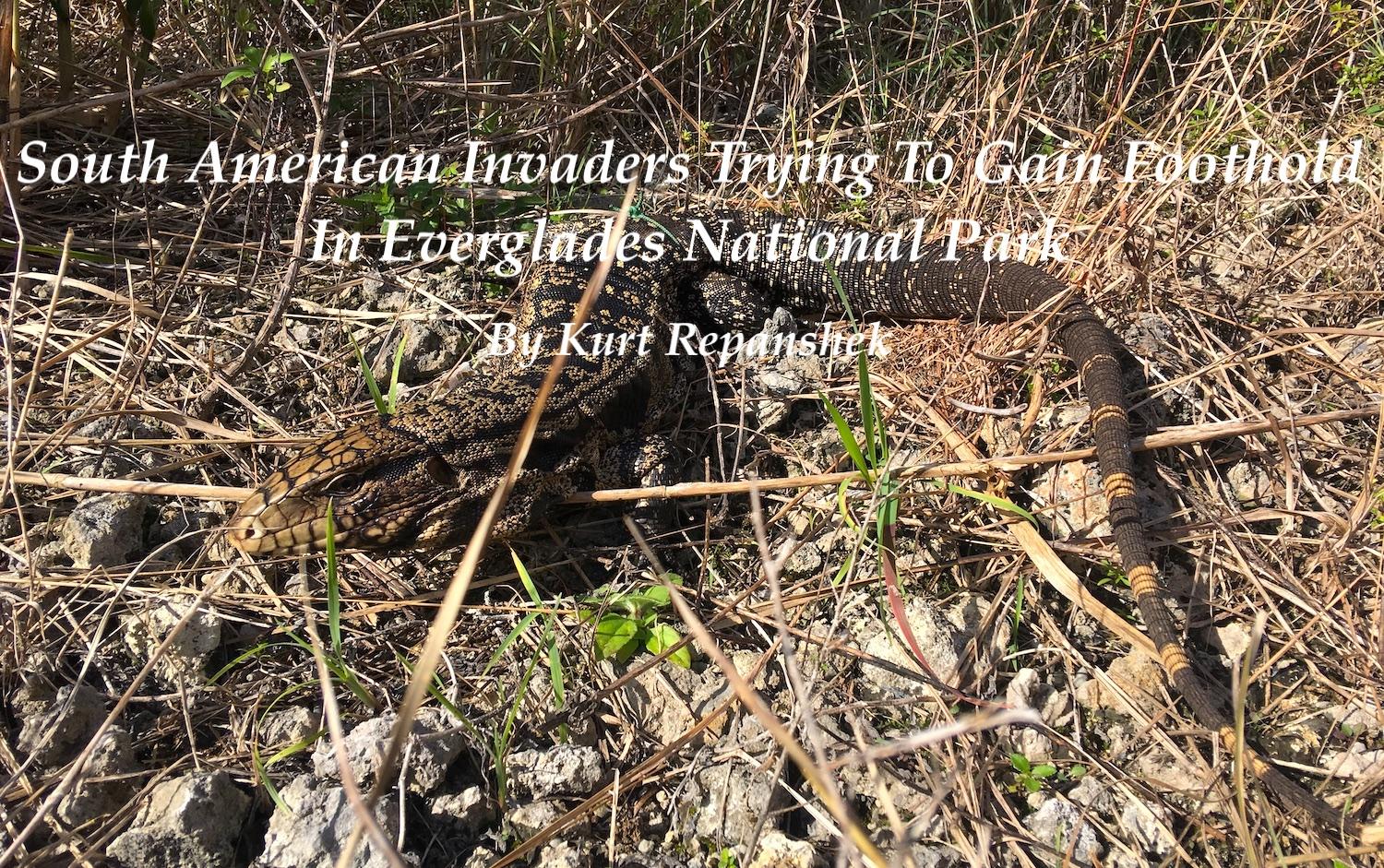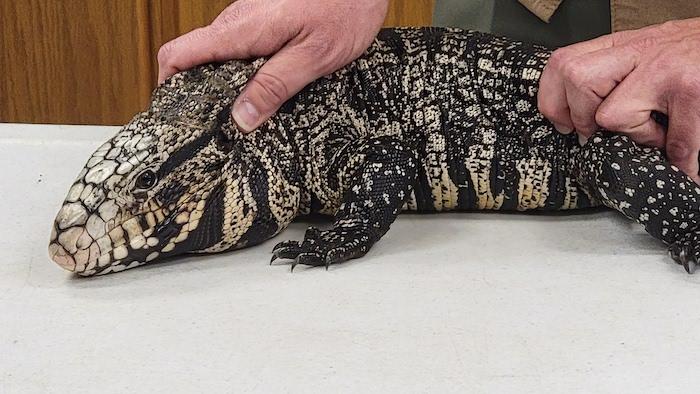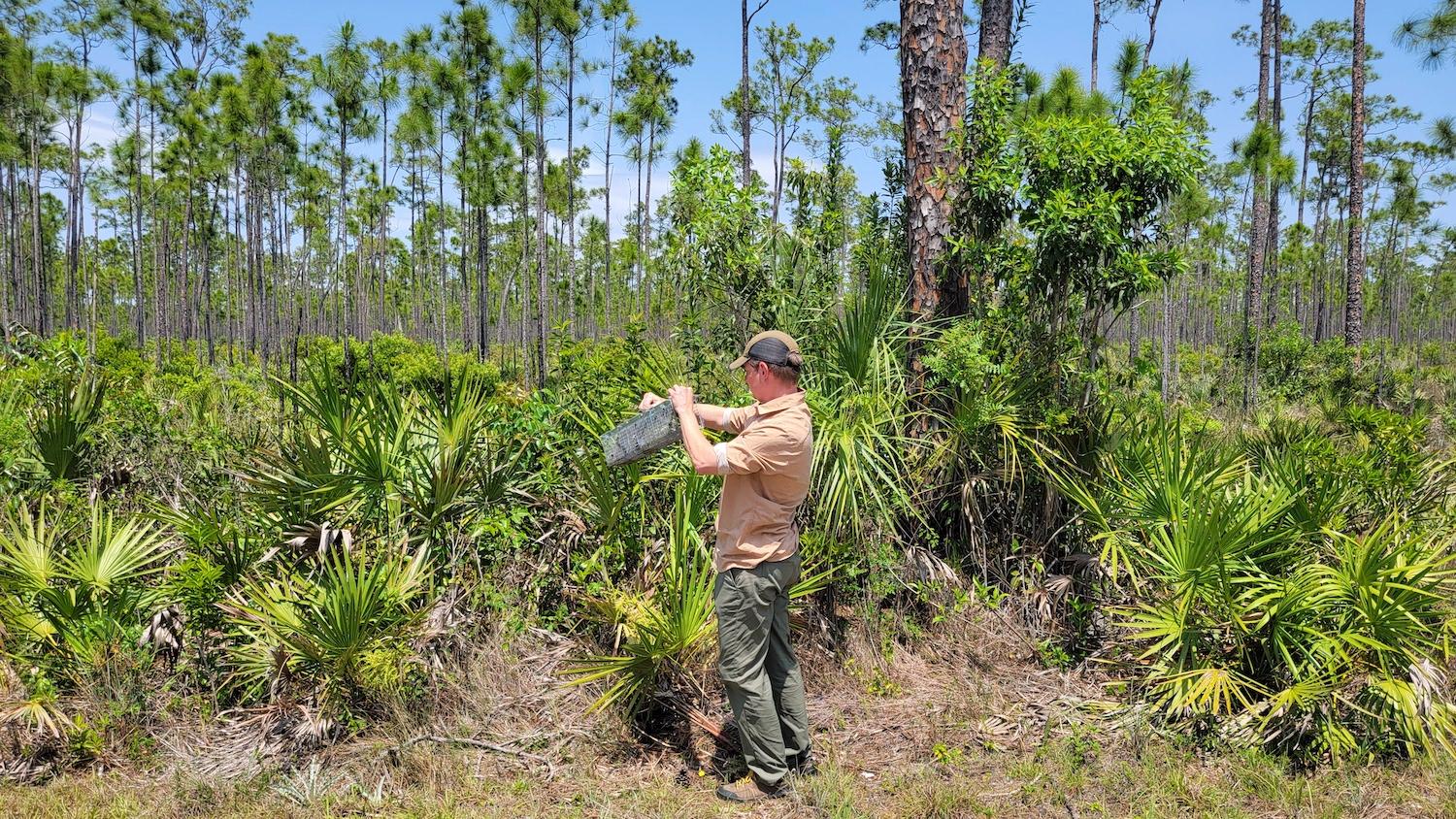
EVERGLADES NATIONAL PARK __ Chicken eggs are pretty good chum, but alligator and crocodile eggs, sea turtle eggs, and even bird eggs are also high on the menu for black-and-white Argentine tegus, a lizard that arrived in Florida through the pet store trade and is threatening, along with other plant and animal species, to upend Everglades National Park's ecosystems.
Though probably not as destructive as Burmese pythons, another invader slithering through the park, tegus (Tay' goo) can grow to 4 or 5 feet in length, rob ground nests of their eggs, and quickly generate a population boom that challenges efforts to drive them out of Everglades.
"They can get up to 10 pounds," said Kevin Donmoyer, an invasive species biologist at the national park. "The size of a small dog. Captive tegus, there's plenty of material on the internet with big tegus walking around people's houses, hanging out with the dogs."
For the past year, the National Parks Traveler writers and editors have been chronicling problems across the National Park System with invasive animal, plant, fish, and even insect species. Our last stop was in April in Everglades National Park, arguably the park system's poster child for invaders. As we've noted, while much work and billions of dollars have been spent to restore the natural flow of the "river of grass" from Lake Okeechobee to Florida Bay, a rejuvenation that should pay huge benefits to the park's flora and fauna, on-the-ground battles continue against invasive predators that have been robbing the park of its small mammals and nonnative vegetation that has overwhelmed portions of the mesmerizing sawgrass prairie.

Eight-hundred or so tegus have been caught since the park staff began capture operations/Kim O'Connell
The pythons, which can grow to more than 17 feet and 160 pounds and are blamed for a staggering reduction -- up to 99 percent in some cases -- of small native mammalian populations in the park, were first documented there in the fall of 1979. Today, thousands of the big snakes are thought to be in the park despite ongoing efforts to catch them.
One battle the park hopes it has the upper hand on involves tegus. These squat, ground-hugging black-and-white tegus (Salvator merianae), which also come in red (Salvator rufescens) and gold (Tupinambis teguixin) varieties, are relative newcomers on the growing list of invasive species that threaten to overrun the park's ecosystems.
Tegus, a black-and-white lizard that isn't venonmous, are native to Brazil, Paraguay, eastern Uruguay and northern Argentina, but they have quickly found Florida's climate to their liking. They tolerate both fresh and saltwater, easily maneuver both tangles of vegetation and the sawgrass prairie, and are adept at taking over other animals' burrows. Plus, there's lots to eat.
A recent U.S. Geological Survey study noted that tegus can adapt to temperatures cooler than the species tolerated in its native Argentina.
"Several lines of evidence from recent USGS research studies published from 2018 to 2021 now provide clear indication for managers that the entire southeast portion of the United States is at risk of tegu establishment if lizard releases continue unabated," said Amy Yackel Adams, a USGS research ecologist earlier this year.
The lizards were first considered a threat to egg-laying species in Florida in 2013, 11 years after they showed up in the state's pet shops. Four years later, they were documented in the park, and in 2020 some hatchlings were captured by staff.
"So we know, at least by 2020, they were breeding [in the park]," Donmoyer said while checking a chicken-egg-baited trap not far from the Daniel Beard Center in the park.
While female tegus can lay nearly three dozen eggs a year, how many are loose in the park is unknown.
"We're not sure what the population is," he said. "With our current methods, while we have been getting better at removing them, we're still not to a point where we can fully achieve something that we would call eradication. The population is still growing. We're trying to learn as much as we can as we go, and just keep bumping up the [capture] numbers, learning more and more about the biology."
Everglades isn't the only spot in Florida where the lizards are creating problems. Statewide more than 12,000 tegus have been captured, according to the Florida Fish and Wildlife Conservation Commission, which has added the lizard to its list of species prohibited in the state.
"Between October and February, they're basically inactive," Donmoyer explained. "When we put the traps out in February and we'll [catch] one or two a week."
Roughly 300 traps have been placed in the park and areas just to the east, and technicians regularly check them during the warm-weather months. By April, the traps were catching 10 or so tegus a day. As the months grow warmer, the lizards grow more active and find their way into traps more often, the biologist said.

Biologist Kevin Donmoyer checks a tegu trap baited with a chicken egg/Kim O'Connell
"The latest models have tegus potentially extending as far north as North Carolina and as far west as Texas, so it's not necessarily just a Florida problem," said Donmoyer. "And there is a population in Georgia. Tegus are extremely generalistic with what they eat, so they will eat fruits, they'll eat insects, mammals, other reptiles. Our big concern here is eggs. They've been documented eating alligator eggs. We know that they'll eat turtle eggs, bird eggs."
The captured lizards are taken to the park's lab, where they are stored in hard-plastic tubs with locking covers. From there they are humanely destroyed and necropsied, the biologist said.
While the battle against tegus continues, there's always the possibility another reptilian invader will show up.
"We don't have monitors [lizards] in the park, that we're aware of," said Donmoyer. "But we have smaller species of lizards. They're mostly, as far as we know, restricted to parking lots. So they're hitch-and-rides on cars, they're in the undercarriage. They jump on in another parking lot and jump off at one of our parking lots. Peter's rock agamas [native to East Africa], northern curly-tailed lizards [native to Bahamas, Cayman Islands, and Cuba]. Those are both nonnative species that you'll find pretty commonly around Florida, especially southern Florida."
But as climate change makes the southern tier of the United States more suitable to Central and South American species, what will be the next invader that threatens the Everglades' ecosystem?
Previous installments in this series:
Traveler Special Report: The Invasion Of The National Park System
Traveler Special Report: Invasive Fish in National Parks
Audio Postcard From The Parks | Battling Russian Olive At Glen Canyon NRA
Traveler Special Report: Vegetative Invaders In The National Parks
Charitable Dollars Help In Fight Against Invasives In National Park System
Traveler Special Report: The Cost Of Invasive Species In The National Park System
Traveler Special Report: Battling Invaders With Fire At National Battlefields
Traveler Special Report: Measuring Successes Against Invasive Species
Traveler's Audio Postcards From The Parks: Hog Wild
Traveler Special Report: Invasive Mammals And The National Parks
Everglades National Park: Ground Zero In The Battle With Invasive Species
Filling The Hole In The Donut At Everglades National Park

Comments
We need to get rid of all invasive animal species that are in this country. It is a matter of time, when we read about a small child eaten by a python or some other carnivore. It is really sad.